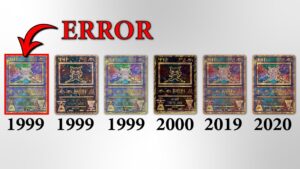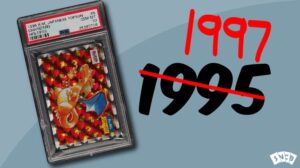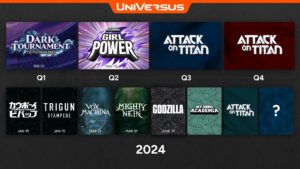5 YuGiOh! Cards That Were Banned (And Why)
-
By: Oliver Copeland
- Published:
- Last Updated: February 6, 2024
The YuGiOh! Trading Card Game is a popular game played all over the world with a Championship Series taking place once a month in North America and Europe. The game is also played locally by amateur players as well.
However, there are certain limitations when it comes to Advanced Format play or official tournaments of the games. There are certain cards that have been banned from usage in tournaments due to them being more powerful than initially intended.
Banned cards can sometimes become valuable because of the ban, so make sure you sleeve these bad boys and hold onto them!
In this list, we aim to talk about 5 popular banned YuGiOh! cards and also discuss the reason for their ban. We’ll only be covering cards that are completely banned across all official tournaments. The YuGiOh! ban list is updated about every three months with cards regularly being removed and added to it.
Card of Safe Return
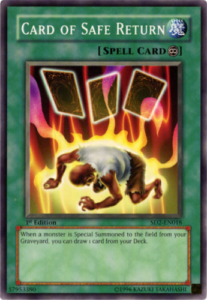
The Card of Safe Return basically allows the player to draw a card whenever a monster is special summoned from the Graveyard. The spell seems quite normal at first but shows its real power when applied continuously.
For certain types of decks, the act of special summoning a GY monster is relatively much more common as compared to others. These decks would be at an unfair advantage as they would be getting maximum draw power.
Some of these decks would exploit this spell by drawing any card they need just by summoning a monster from the Graveyard. This is the reason the Card of Safe Return was banned from all tournaments and it isn’t likely that it going to return anytime soon.
Last Turn
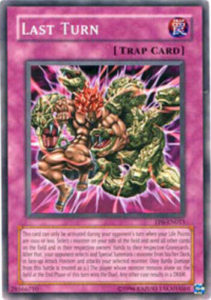
First released in English in 2003, Last Turn enables the player to summon a monster to the battle, the opponent is also given the choice to special summon a monster of their choice. Quite accurate to the card’s name, the winner of the following battle would win the duel. One might think that apparently, the game looks fair and square, then what’s the problem?
This is a prime case of when players learn to manipulate the abilities of a card to an extent that it has to be banned. As the card saw more and more competitive play, players exploited the card’s rule by choosing monsters that prevent the opponent from selecting a monster of their choice for battle. This put the opponent at an obvious disadvantage, hence, the card had to be banned.
Pot of Greed
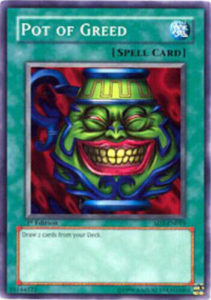
A very popular card and a great collectible, the Pot of Greed allowed players to draw two cards from their deck without any cost or penalty. This ability made it very powerful and the player holding it would always be at an advantage.
The decks that had more than two of these cards saw complete dominance in their matches. Due to its ability to generate a lot of draw power, Pot of Greed could easily turn the tide of battle in any match. It was consequently banned and now only remains as a collectible, never to be played with again.
Victory Dragon
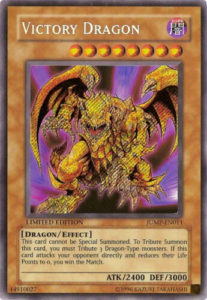
Another extremely formidable card, Victory Dragon was released to the TCG in 2007. In its initial days prior to the ban, the card was incredibly hard to deal with. The card basically asks for a tribute of three dragon-type monsters in order to be summoned. Once summoned, if the Victory Dragon can get your opponent’s health to 0 by attacking it directly, you win the entire match! Yes, the full match, not just the duel.
So, whenever a player would win by way of the Victory Dragon, the entire game is over and you move directly onto the next round in a tournament. Now, it isn’t quite hard to tell why a card like that would get banned. Some players even forfeited before the Dragon could attack so that they’d just lose the duel and not the full game.
The card was too overpowered for competitive play and hence, was permanently banned from all formats.
Painful Choice
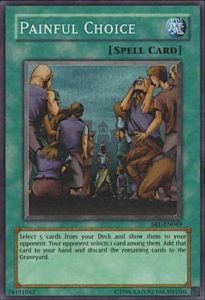
Painful Choice basically allows the player to select 5 cards from their deck and present them to the opponent. The opponent will then choose one card that will go to the player’s hand, while the remaining 3 cards go to the Graveyard. Initially, this card presented a type of risk/reward scenario, where you could get one card of your choice but lose four in the process.
However, with advances in the TCG, it was seen that cards being in the graveyard can act as an advantage for various types of decks that rely on those cards. In fact, many decks completely drive the game from GY cards. Through Painful Choice, players could send a lot of cards into the Graveyard, which put their decks at an obvious advantage.
Hence, even the negative aspects of the card were not really negative, quite the opposite actually. At last, it was banned, never to return again.
Conclusion
These were 5 YuGiOh! Cards that Were Banned, many of these cards were extremely popular in their respective eras. There is a huge number of cards in the YuGiOh! ban list, with new ones being added regularly. Makes you wonder how far the TCG has gotten in terms of competitive play.

